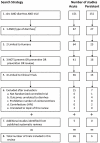Therapeutic value of zinc supplementation in acute and persistent diarrhea: a systematic review
- PMID: 20442848
- PMCID: PMC2860998
- DOI: 10.1371/journal.pone.0010386
Therapeutic value of zinc supplementation in acute and persistent diarrhea: a systematic review
Abstract
Background: For over a decade, the importance of zinc in the treatment of acute and persistent diarrhea has been recognized. In spite of recently published reviews, there remain several unanswered questions about the role of zinc supplementation in childhood diarrhea in the developing countries. Our study aimed to assess the therapeutic benefits of zinc supplementation in the treatment of acute or persistent diarrhea in children, and to examine the causes of any heterogeneity of response to zinc supplementation.
Methods and findings: EMBASE, MEDLINE and CINAHL databases were searched for published reviews and meta-analyses on the use of zinc supplementation for the prevention and treatment of childhood diarrhea. Additional RCTs published following the meta-analyses were also sought. The reviews and published RCTs were qualitatively mapped followed by updated random-effects meta-analyses, subgroup meta-analyses and meta-regression to quantify and characterize the role of zinc supplementation with diarrhea-related outcomes. We found that although there was evidence to support the use of zinc to treat diarrhea in children, there was significant unexplained heterogeneity across the studies for the effect of zinc supplementation in reducing important diarrhea outcomes. Zinc supplementation reduced the mean duration of diarrhea by 19.7% but had no effect on stool frequency or stool output, and increased the risk of vomiting. Our subgroup meta-analyses and meta-regression showed that age, stunting, breast-feeding and baseline zinc levels could not explain the heterogeneity associated with differential reduction in the mean diarrheal duration. However, the baseline zinc levels may not be representative of the existing zinc deficiency state.
Conclusions: Understanding the predictors of zinc efficacy including the role of diarrheal disease etiology on the response to zinc would help to identify the populations most likely to benefit from supplementation. To improve the programmatic use of zinc, further evaluations of the zinc salts used, the dose, the frequency and duration of supplementation, and its acceptability are required. The significant heterogeneity of responses to zinc suggests the need to revisit the strategy of universal zinc supplementation in the treatment children with acute diarrhea in developing countries.
Conflict of interest statement
Figures




References
-
- O'Ryan M, Prado V, Pickering LK. A millennium update on pediatric diarrheal illness in the developing world. Semin Pediatr Infect Dis. 2005;16:125–136. - PubMed
-
- Turner SM, Scott-Tucker A, Cooper LM, Henderson IR. Weapons of mass destruction: virulence factors of the global killer enterotoxigenic Escherichia coli. FEMS Microbiol Lett. 2006;263:10–20. - PubMed
-
- Bhan MK. Current and future management of childhood diarrhoea. Int J Antimicrob Agents. 2000;14:71–73. - PubMed
-
- Curtis V. Talking dirty: how to save a million lives. Int J Environ Health Res. 2003;13(Suppl 1):S73–79. - PubMed
Publication types
MeSH terms
Substances
LinkOut - more resources
Full Text Sources
Medical

